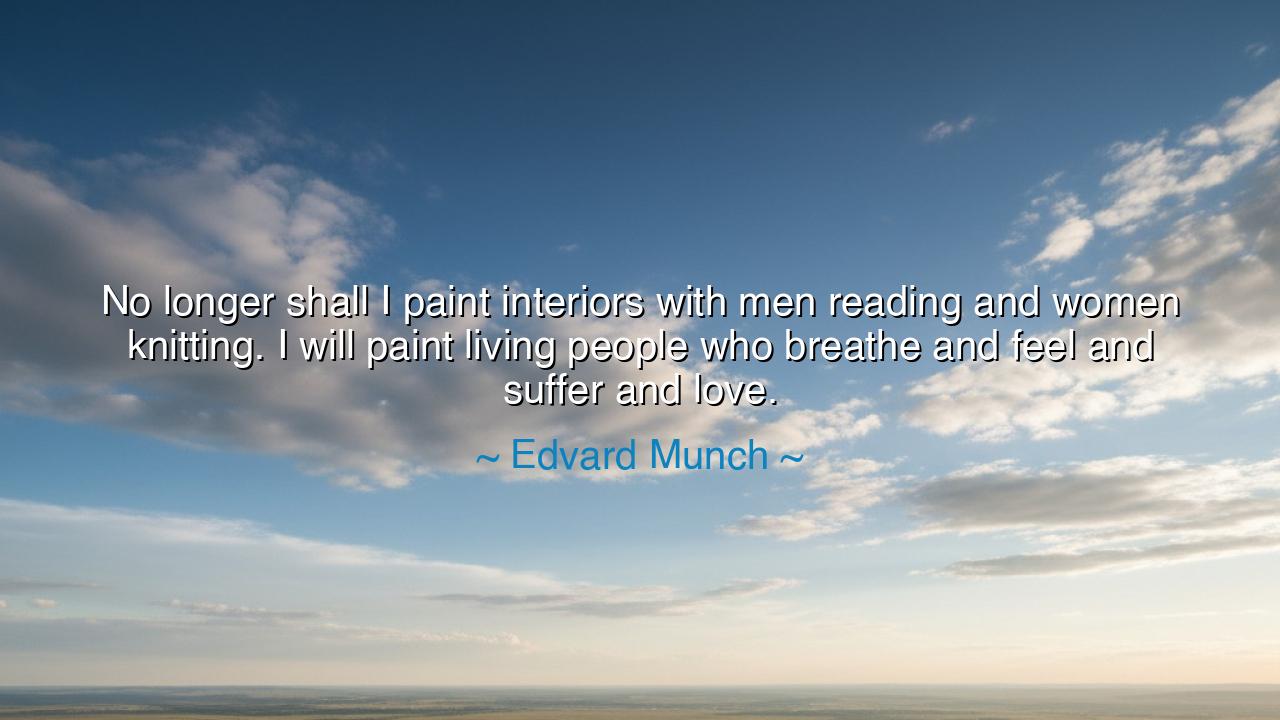
No longer shall I paint interiors with men reading and women
No longer shall I paint interiors with men reading and women knitting. I will paint living people who breathe and feel and suffer and love.






Hear the words of Edvard Munch, a man whose soul was touched by the raw forces of emotion and whose art spoke of the deepest human experiences. "No longer shall I paint interiors with men reading and women knitting. I will paint living people who breathe and feel and suffer and love." In these words, Munch casts aside the shallow comforts of idealized, peaceful domestic scenes and declares his commitment to painting the truth of life itself—the messy, tumultuous, and often painful essence of the human experience. He speaks of a world where humanity is not simply depicted in its most tranquil and neat moments but in its most vulnerable, authentic, and alive states.
For too long, art had been trapped in decorum—a representation of life that was neat, ordered, and sanitized. Men reading, women knitting, these were symbols of a life lived quietly, removed from the intensity of real human emotions. But Munch saw something deeper, something far more profound beneath the surface. He understood that life was not simply about moments of quiet passivity but about the chaos and the passion that define human existence. Love, suffering, fear, and joy—these are the true colors of the human soul, and Munch sought to capture them in their purest form.
Think of the great philosopher Plato, who taught that the true essence of life is found not in the surface appearances of things, but in the deeper, unchangeable truths that lie beneath. Plato spoke of the ideal forms, those perfect representations of the world’s greatest virtues, but he also understood that in life, we must confront the imperfections of the world as it is. It was through this struggle—this engagement with the messy and imperfect—that we could achieve true wisdom. Munch’s art was a reflection of this same truth—that it is in the rawness of human experience, in the moments of deep pain and profound love, that the true beauty of life is revealed.
Consider, too, the famous painting by Munch, The Scream, which is perhaps his greatest testament to the intensity of human emotion. In this image, a figure stands in anguish, its mouth open in a cry that reverberates across time. This is not a peaceful world of men reading or women knitting; this is a world of suffering, alienation, and existential dread. Munch saw the scream as an expression of the very essence of being—an outpouring of all that is suppressed, repressed, and hidden within the human spirit. Through this painting, he shattered the notion that art should be serene and controlled. Instead, he painted the life that breathes, that feels, and that suffers.
The story of Vincent van Gogh offers another example of an artist who sought to break free from the conventions of his time and capture the rawness of life. Van Gogh’s work, like Munch’s, is filled with vibrant colors, chaotic swirls, and intense emotional expression. In his famous painting, Starry Night, the swirling sky is not calm or still but full of life, bursting with energy. Van Gogh, too, understood that life is not a static, quiet moment, but a swirling, dynamic force. Both he and Munch sought to show not just the outward appearance of things but the inner turmoil, the emotions, and the passions that shape us.
The lesson here, dear listener, is this: life is not a still picture; it is a living force, full of emotion, struggle, and growth. We are not simply men who read and women who knit—we are people who breathe, feel, and live. Our experiences are raw, unrefined, and often painful, yet it is in these very experiences that we find our deepest truths. Like Munch and van Gogh, we must not shy away from the intensity of life but embrace it in all its forms, for it is through our suffering and love that we truly understand ourselves and the world around us.
So I say to you, do not be afraid to feel, to experience, and to express the fullness of your humanity. Life is not a quiet, orderly affair—it is a storm of emotions, and in that storm, you will find the truths that will guide you. Just as Munch abandoned the comfort of conventional representations of life, so too must you step beyond the safe and easy and dive into the depths of your own experience. Paint the world as you see it—not as it should be, but as it is. In the rawness of your expression, in the vibrancy of your emotions, you will find the true beauty of life.






AAdministratorAdministrator
Welcome, honored guests. Please leave a comment, we will respond soon